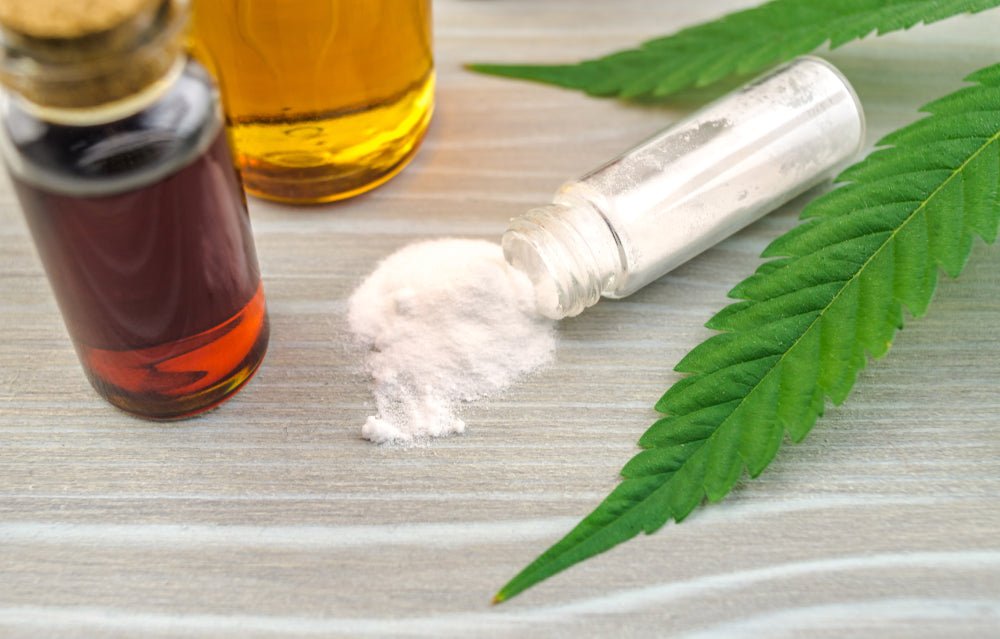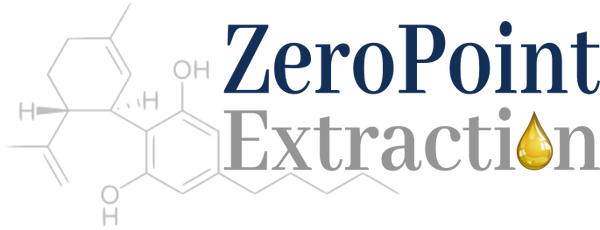Recent posts
-

-
 What Are THCa Diamonds?October 14, 2025
What Are THCa Diamonds?October 14, 2025 -
 Delta 9 Gummies GuideOctober 8, 2025
Delta 9 Gummies GuideOctober 8, 2025 -
 Head High vs Body High: A Guide to Cannabis EffectsOctober 1, 2025
Head High vs Body High: A Guide to Cannabis EffectsOctober 1, 2025 -
 What is THCA Crumble?September 22, 2025
What is THCA Crumble?September 22, 2025 -
 10 Ways to Elevate Self-Care Awareness MonthSeptember 14, 2025
10 Ways to Elevate Self-Care Awareness MonthSeptember 14, 2025

What is CBGA Isolate?
By Zero Point
Table of Contents
Introduction to CBGA Isolate
Cannabigerolic acid (CBGA) isolate represents a pinnacle of specificity in the world of cannabis-derived products. Standing at the crossroads of modern botanical science and traditional herbal medicine, CBGA isolate is a purified form of one of the cannabis plant's most foundational compounds. As the precursor to many other cannabinoids, including THC and CBD, CBGA is often referred to as the "mother of all cannabinoids."
The intrigue surrounding CBGA isolate lies not only in its potent purity but also in its relatively recent entrance into the cannabis market spotlight. While consumers and researchers have long celebrated the benefits of more commonly known cannabinoids, the focus on isolates like CBGA underscores a broader trend towards specificity, customization, and targeted therapeutic potential in cannabis research and product development.
The exploration of CBGA's benefits is still unfolding, with early studies suggesting a range of potential health and wellness applications. Its emergence as a key player in the cannabinoid space is a testament to the ever-evolving understanding of cannabis's complex chemistry and its potential to offer novel solutions to a broad spectrum of needs.
This post aims to demystify CBGA isolate, tracing its roots from a fundamental component of cannabis biochemistry to a standalone product with unique promise. We'll delve into its discovery, the science behind its production, and the potential it holds for both medical and recreational cannabis communities.
Understanding Cannabinoids
Cannabinoids are a class of diverse chemical compounds that act on cannabinoid receptors in cells, altering neurotransmitter release in the brain. These compounds are predominantly found in the cannabis plant and are the primary drivers of its various physiological effects. Among the hundreds of cannabinoids, delta-9-tetrahydrocannabinol (THC) and cannabidiol (CBD) are the most well-known, celebrated for their psychoactive and therapeutic benefits, respectively. However, the cannabis plant's complexity extends far beyond these two compounds.
CBGA (cannabigerolic acid) stands out as a cornerstone in the cannabinoid family. Often dubbed the "stem cell" cannabinoid, CBGA serves as a precursor to three major cannabinoid lines: THCA (tetrahydrocannabinolic acid), CBDA (cannabidiolic acid), and CBCA (cannabichromenic acid). Through enzymatic processes within the cannabis plant, CBGA is converted into these different acids, which can then be decarboxylated (through heat and drying) into their more familiar active forms: THC, CBD, and CBC.
Understanding CBGA's role is crucial for grasping the potential of CBGA isolate. Unlike its more famous derivatives, CBGA is not typically present in large quantities in most cannabis strains. Its fleeting presence, combined with its pivotal role in cannabinoid synthesis, makes it both a scientific curiosity and a valuable compound for exploration.
The differentiation between cannabinoids like CBGA and its more famous counterparts lies not just in their effects or concentrations within the plant, but in their potential applications. While THC and CBD have been extensively studied, the exploration into CBGA and other lesser-known cannabinoids is just beginning, promising a new frontier of potential health and therapeutic benefits.
Origin and Discovery of CBGA
The journey to understanding CBGA (cannabigerolic acid) and its significance within the cannabis plant's biochemistry is both fascinating and complex. Unlike its counterparts THC and CBD, which have been subjects of research and cultural discussion for decades, CBGA has only recently begun to emerge from the shadows, despite its central role in cannabinoid formation.
Early Research and Identification
The discovery of CBGA dates back to the 1960s, a pioneering era for cannabis research. It was during this time that scientists began to unravel the chemical complexity of the cannabis plant, identifying and isolating various cannabinoids. The early research was primarily focused on THC, due to its psychoactive properties. However, as researchers delved deeper, they uncovered the existence of CBGA, a non-psychoactive cannabinoid that serves as a chemical precursor to the three main cannabinoid lines: THCA, CBDA, and CBCA.
Yechiel Gaoni and Raphael Mechoulam, two Israeli chemists, were instrumental in the early studies of cannabinoids. In 1964, they isolated and synthesized THC, laying the groundwork for further cannabinoid research. Following this breakthrough, attention gradually turned towards understanding the biosynthetic pathways of cannabinoids, leading to the identification of CBGA as the "mother cannabinoid," critical for the synthesis of other cannabinoids.
Biosynthesis of Cannabinoids
The significance of CBGA in the cannabis plant's biochemistry cannot be overstated. In the plant's trichomes, CBGA is synthesized through the action of olivetolic acid and geranyl pyrophosphate, two precursor molecules. This process results in the formation of CBGA, which then serves as a substrate for three enzymes that convert it into THCA, CBDA, or CBCA, depending on the plant's enzyme composition.
This biosynthetic pathway was elucidated through decades of research, highlighting CBGA's role as a cornerstone in cannabinoid formation. The understanding of this process not only deepened the scientific community's knowledge of plant biology but also opened up new avenues for the breeding of cannabis strains with specific cannabinoid profiles.
Historical Context and Modern Implications
The historical context of CBGA's discovery and research is intertwined with the broader narrative of cannabis regulation and cultural attitudes. For many years, the legal and societal challenges faced by cannabis research impeded the exploration of cannabinoids beyond THC and CBD. However, as attitudes toward cannabis have shifted globally, there has been a renewed interest in the plant's less understood components, including CBGA.
Modern scientific methods and the legalization of cannabis in various regions have facilitated more in-depth studies on CBGA, leading to a reevaluation of its potential. Researchers are now exploring CBGA's unique properties and potential therapeutic benefits, untethered from the constraints that once limited cannabis science.
The transition from a mysterious, under researched compound to a substance of significant scientific interest reflects the evolving understanding of cannabis and its potential for medicine and wellness. CBGA's journey from obscurity to prominence is not just a testament to the advancements in cannabinoid research but also an indication of the changing societal perceptions of cannabis and its compounds.
The Science Behind CBGA Isolate
The journey from a naturally occurring compound within the cannabis plant to a purified isolate like CBGA (cannabigerolic acid) represents a fascinating intersection of botany, chemistry, and technology. Understanding this process not only illuminates the complexities of cannabinoid science but also highlights the innovative methods used to harness the potential of these compounds for research and therapeutic use.
Isolation and Purification
CBGA isolate is the result of a meticulous extraction and purification process that separates CBGA from the myriad of other compounds found in the cannabis plant. The goal is to achieve a product that is nearly 100% pure CBGA, free from other cannabinoids, terpenes, and plant materials. This process typically involves several steps, beginning with the extraction of crude oil from cannabis plant material, which contains a mixture of cannabinoids, including CBGA.
The initial extraction is often performed using solvents like CO2, ethanol, or hydrocarbons, which dissolve the desired compounds from the plant matter. The resulting crude extract then undergoes further refinement processes, such as winterization to remove fats and waxes, and distillation to concentrate the cannabinoids.
The critical step in producing CBGA isolate is chromatography, a technique used to separate and purify compounds based on their chemical properties. Through chromatography, CBGA is isolated from other cannabinoids and impurities, resulting in a highly pure form of CBGA. This isolate can then be used for various research and product formulation purposes, allowing scientists and manufacturers to explore the specific effects and benefits of CBGA without the influence of other cannabis compounds.
Chemical Structure and Stability
CBGA's chemical structure is foundational to understanding its role in the cannabis plant and its potential applications. As an acid form of cannabigerol (CBG), CBGA features a carboxyl group that makes it more soluble in water than its decarboxylated counterpart, CBG. This chemical property influences how CBGA can be used in formulations and its stability under different conditions.
CBGA, like other cannabinoid acids, is sensitive to heat and light, which can cause it to decarboxylate into CBG. This sensitivity requires careful handling and storage to maintain its purity and efficacy. Understanding these properties is crucial for researchers and product developers working with CBGA isolate, as it affects how the compound can be utilized in medical research, product development, and therapeutic applications.
From Science to Application
The isolation of CBGA has opened up new avenues for research, allowing scientists to study its effects in isolation from other cannabinoids. This research is crucial for understanding the full scope of CBGA's therapeutic potential, including its anti-inflammatory, neuroprotective, and anti-bacterial properties. Moreover, the ability to produce CBGA isolate has significant implications for the development of cannabinoid-based products, offering the possibility of targeted therapies that leverage the specific benefits of CBGA.
The science behind CBGA isolate not only demonstrates the technical achievements in cannabinoid extraction and purification but also underscores the growing interest in exploring the nuanced effects of individual cannabinoids. As our understanding of these compounds deepens, the role of isolates like CBGA in advancing medical research and developing innovative health and wellness products will likely continue to expand.
Benefits and Uses of CBGA Isolate
CBGA (cannabigerolic acid) isolate, a pure form of one of the cannabis plant's foundational compounds, has begun to draw significant interest from the medical research and wellness communities. As our understanding of cannabinoids expands, so does our appreciation for the potential health benefits that these compounds, including CBGA, may offer. The isolation of CBGA allows for targeted research and application, opening up new possibilities for therapeutic use.
Potential Health Benefits
The exploration into CBGA's health benefits is still in its early stages, but preliminary research and anecdotal evidence suggest a promising range of therapeutic properties:
-
Anti-inflammatory Properties: Like many cannabinoids, CBGA has shown potential as an anti-inflammatory agent. This could make it useful in treating conditions characterized by inflammation, such as arthritis and inflammatory bowel disease (IBD).
-
Neuroprotective Effects: There is emerging evidence to suggest that CBGA may have neuroprotective properties, offering potential benefits for neurodegenerative diseases like Huntington’s disease and Parkinson's disease. CBGA might protect nerve cells from damage and support brain health.
-
Antibacterial Properties: CBGA has demonstrated antibacterial activity, particularly against drug-resistant bacterial strains. This suggests it could play a role in developing new antibacterial treatments at a time when antibiotic resistance is a growing global concern.
-
Cancer Research: Some studies have indicated that CBGA might inhibit the growth of certain cancer cells, including breast cancer. By inducing apoptosis (programmed cell death) and inhibiting cell growth, CBGA holds potential as a compound of interest in cancer research.
-
Metabolic Disorders: Early research hints at CBGA's role in combating metabolic disorders. Its effect on certain enzymes and metabolic processes could make it a candidate for treating obesity and type 2 diabetes.
Uses in Wellness and Medicine
The potential benefits of CBGA have spurred interest in its use across various wellness and medical applications. While the research is still evolving, the isolation of CBGA has paved the way for its incorporation into products and therapies aimed at improving health outcomes.
-
Dietary Supplements: CBGA isolate can be found in dietary supplements, designed to support overall wellness. These products are aimed at leveraging CBGA’s anti-inflammatory and neuroprotective properties to promote general health and well-being.
-
Topical Applications: In the realm of dermatology and skin care, CBGA is being explored for topical applications. Its anti-inflammatory and antibacterial properties may help treat conditions like acne, psoriasis, and eczema, offering a natural alternative to traditional treatments.
-
Pharmaceutical Research: The pharmaceutical industry is investigating CBGA for its potential in drug development. Its varied therapeutic properties make it a candidate for creating new treatments for chronic diseases and conditions currently lacking effective therapies.
-
Personalized Medicine: The purity and specificity of CBGA isolate make it particularly interesting for the field of personalized medicine. It offers the potential to tailor treatments to individual needs, maximizing therapeutic benefits while minimizing side effects.
Challenges and Considerations
Despite the promising potential of CBGA, there are challenges to its widespread adoption and use. The regulatory landscape for cannabinoids remains complex and varied by jurisdiction, affecting the availability and research of CBGA-based products. Additionally, more comprehensive clinical trials are needed to fully understand CBGA's efficacy and safety profile across different populations and conditions.
Legal and Regulatory Considerations
The legal and regulatory landscape for CBGA isolate, like that for other cannabinoids, is complex and varies significantly across different jurisdictions. These regulations can influence everything from the research and development of CBGA-based products to their manufacture, sale, and use. Understanding these legal frameworks is crucial for anyone involved in the cannabinoid industry, from researchers to producers and consumers.
Global Variation in Cannabis Regulation
Globally, the legal status of cannabis and its derivatives, including CBGA, ranges from full prohibition to regulated medicinal use, and in some cases, decriminalization or legalization for recreational use. This patchwork of regulations affects the availability of CBGA isolate and related products, influencing both market dynamics and research opportunities.
In countries or regions where cannabis is legal for medical or recreational use, there tends to be more freedom for the production and sale of CBGA products. However, even in these areas, regulatory bodies may impose strict guidelines on the extraction processes, purity standards, labeling, and marketing of CBGA and other cannabinoid isolates.
Impact on Research and Development
Legal restrictions in many parts of the world have historically hampered cannabinoid research, limiting scientists' ability to study CBGA and other compounds. However, as the medicinal and therapeutic potential of cannabinoids gains wider recognition, there is a growing push for regulatory reform to facilitate research and development. This is gradually opening up new avenues for exploring CBGA's properties and applications.
Consumer Access and Use
For consumers, the legal status of CBGA and cannabinoid products directly impacts access. In jurisdictions with medicinal cannabis programs, patients may obtain CBGA products with a prescription or under a healthcare provider's guidance. In areas where cannabis is legalized for adult use, consumers may find CBGA products available in dispensaries or specialty stores, subject to regulatory compliance.
Conclusion
The evolving legal and regulatory environment for CBGA and other cannabinoids presents both challenges and opportunities. As laws continue to change in response to shifting attitudes and a deeper understanding of cannabis's benefits, the potential for CBGA isolate to contribute to health, wellness, and medical science grows. Stakeholders must navigate these complexities carefully, staying informed and compliant with the regulations governing cannabinoid production, sale, and use in their respective regions.








